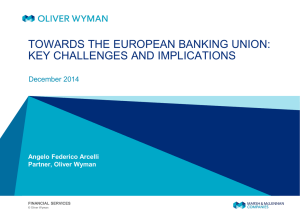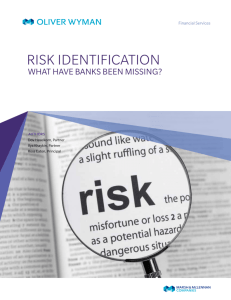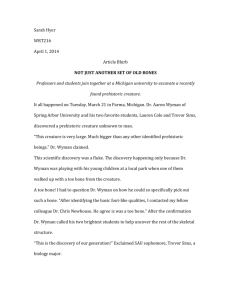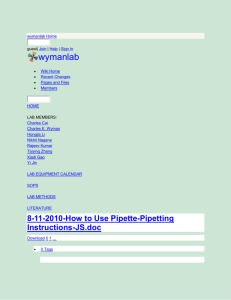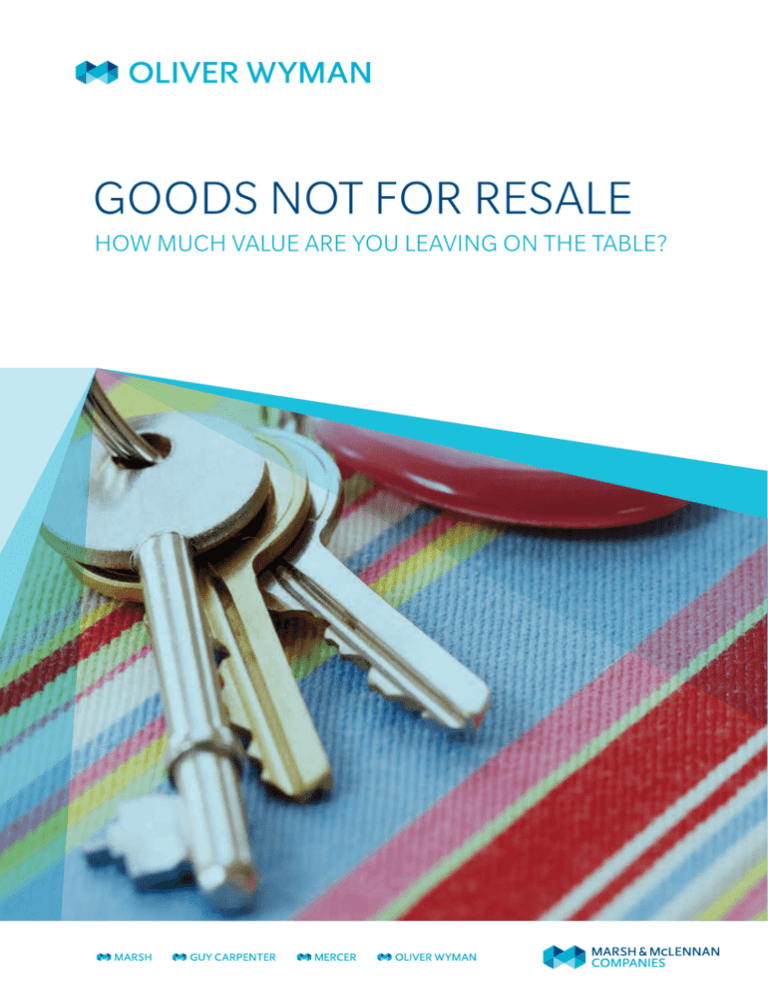
GOODS NOT FOR RESALE
HOW MUCH VALUE ARE YOU LEAVING ON THE TABLE?
GOODS NOT FOR RESALE
HOW MUCH VALUE ARE YOU LEAVING ON THE TABLE?
In tough times, retailers are always looking to increase operational efficiency
and reduce costs. But there’s one place they seldom look hard enough: goods
not for resale (GNFR). GNFR typically represents around 25% of a retailer’s
total operating cost, meaning that it accounts for 6–8% of revenues. Despite its
importance, GNFR is rarely scrutinised in the same way as other costs such as
in-store labour – making it a major source of untapped savings, even for retailers
who have already tried clamping down on spend.
The simplest way to deal with GNFR is through temporary cost cuts or simplistic budget
adjustments: “no travel and entertainment for the time being”, “take 10% out of the marketing
budget”, or “no new computers this year”. These approaches are often perceived by employees
as arbitrary, and they don’t generate sustainable savings. Because ways of working and
patterns of spending remain unchanged, costs creep back and, in some cases, even increase.
Even for retailers that have run significant GNFR programmes or built dedicated groups
to address GNFR, the untapped potential often remains considerable. How can this be?
In simple terms, this is because many purchasing categories are not covered or only the
basic performance levers are pulled.
Only a small number of retailers have successfully set up a holistic GNFR operating system,
adopting best practices from leading manufacturing companies. This capability gives these
retailers a real competitive edge, generating substantial and sustainable savings, while at
the same time leveraging supplier innovations to improve commercial effectiveness and the
customer experience.
2
Copyright © 2014 Oliver Wyman
WHAT ARE GOODS NOT FOR RESALE?
A common belief is that GNFR consists only of simple products and services, such as bags
and cleaning, and that it’s simple to manage. This is wrong in a number of respects.
Firstly, GNFR has various segments that require different approaches, and where retailers’ cost
management capabilities tend to be at very different levels of maturity, as shown in Exhibit 1:
•• Consumables (for example, checkout bags, packaging for fresh products, anti-theft
devices) characterised by low unit prices, high purchasing volumes, a fragmented
supplier base, and high volume purchase orders. In some ways these can be similar to
goods for resale (GFR) when it comes to procurement
•• Equipment (for example, store shelves, cooling systems, power equipment) requiring a
comprehensive and often complex total cost of ownership (TCO) view, detailing several
cost dimensions such as installation, maintenance, spare parts, and energy consumption
•• Services (for example, IT services, cleaning, security, temporary labour) requiring
complex standardisation and volume pooling arrangements across stores
Secondly, GNFR covers both operating expenses and capital expenditures, both of which
require specific budgeting constraints and dedicated decision processes. This complexity makes
it difficult to see the integrated financial picture: if real estate purchases elevators but operations
pays for their maintenance and repair, it can be hard to know what they really cost.
Exhibit 1: GNFR MACRO SPEND CATEGORIES AND TYPICAL MATURITY LEVELS
BUILDING
RETAIL SPECIFIC
“CLASSIC” INDIRECT
Construction
Refurbishment
Shopping trolleys
Cooling systems
Shelf systems
Rents
Packaging
Decorations
Infrastructure
CAPEX
Marketing
Advertising
Professional services
Energy and waste
Office supplies
Travel
Temp. workers
FACILITY MANAGEMENT
OPEX
Maintenance
Others (reception, etc.)
Cleaning
Security
SUPPLY CHAIN
Transport
Logistics
+
Copyright © 2014 Oliver Wyman
++
PURCHASING MATURITY
+++
3
Thirdly, some GNFR categories can be considered as highly sensitive, making them
“exceptions to the rule” when it comes to managing costs. This can be because of:
•• Internal organisational prerogatives: IT, marketing, and logistics, for example, are
often “protected areas” outside the scope of procurement
•• HR considerations: some policies may impact on employee morale (for example, travel
and entertainment, company vehicles)
•• Visibility to customers: cutting spend in customer-facing areas (such as store cleaning,
checkout bags, cooling equipment reliability, or checkout systems) can translate into
lost revenue
And finally, GNFR is characterised by large numbers of prescribers and users scattered
throughout the organisation, meaning that decision-making processes are highly
decentralised. This in itself gives rise to some major challenges. What this means is that
retailers’ scope is usually too narrow when it comes to managing GNFR expenditure.
In general, the spending being considered accounts for less than half of the total cost
base, and the ways retailers think about reducing it are too limited. As a result, most of
the available value remains untapped.
WHAT’S AT STAKE?
GNFR is a significant cost item, typically representing 6–8% of a retailer’s total revenue.
In our experience, there is scope to reduce GNFR spend by between 10% and 15% of
savings over three years: a total cost reduction of 50–100+ basis points. In any retail
sector, the value at stake is enormous. But achieving these results takes much more than
simply optimising procurement transactions through renegotiation or volume pooling.
Fundamentally, there are three ways to manage GNFR costs: buy cheaper, spend better
Exhibit 2: THREE PERFORMANCE MACRO LEVER TYPES TO BE LEVERAGED
GNFR SAVINGS POTENTIAL
BUY CHEAPER
•
•
•
•
•
Volume pooling
Supplier panel optimisation
Alternative sourcing
Master agreement
…
•
•
•
•
•
Standardised catalogue creation
TCO trade-offs
Specification improvement
Make or buy decisions
…
•
•
•
•
•
Consumption monitoring
Best practices roll-out
Budget constraint
Using substitutes
…
33%
25%
50%
+
SPEND BETTER
33%
50%
25%
+
SPEND LESS
25%
+
4
33%
++
PURCHASING MATURITY
25%
+++
Copyright © 2014 Oliver Wyman
and spend less – Exhibit 2 shows the savings potential of each. To get the most from GNFR
optimisation, all three must be applied in a coordinated way.
BUY CHEAPER
Most retailers focus their GNFR cost reduction efforts on a subset of the things they buy, and
on buying cheaper: in other words, purchasing essentially the same products or services
for a lower price through enhanced competition, pooled volumes, or renegotiation with
suppliers. Of course, this is often where quick wins are found and where there will be the
least friction between procurement and the rest of the business. But innovative or alternative
levers can offer additional savings: for instance, some retailers have set up disruptive antitheft devices or more creative sourcing schemes, leveraging low-cost countries sourcing
price opportunities combined with their GFR import structure to optimise total costs.
SPEND BETTER
Spending better is about shifting the focus from the product being bought to the
business need it satisfies. This might mean challenging specifications or ensuring
the actual “need” conforms to catalogue standards; in all cases, the aim is to have
an impact on the procurement activities downstream.
For instance, when specifications for store shelves are managed locally in different countries
and for different formats, the final number of SKUs purchased can easily total several thousand,
and this naturally constrains the buyers during negotiations. To reduce this complexity, some
retailers have set up a common standard for shelf structures based on corporate rules combined
with a catalogue of accessories, as shown in Exhibit 3. This enables them to take into account all
local variations: each country can “rebuild” its own store shelves by using different accessories,
and buyers can pool volumes based on simplified and common standard catalogues.
Exhibit 3: STORE SHELVES SPEND OPTIMISATION EXAMPLE
HOW TO LIMIT SKU PROLIFERATION WHILE KEEPING LOCAL MARKET SPECIFICITIES
GROUP CATALOGUE OF STRUCTURES
GROUP CATALOGUE OF ACCESSORIES
Alignment of specification
through common
structures catalogue
Adaptation to local needs
via the accessories catalogue
Maximum
height = 2.2m
One set of
accessories to
build wine shelves
in country #1
Single back panel
No plinth
Low foot
Copyright © 2014 Oliver Wyman
Different set of
accessories
to build
wine shelves
in country #2
5
SPEND LESS
Spending less – in essence, reducing volume – is conceptually simple but tricky to implement.
In many cases it isn’t worth optimising costs by buying cheaper and/or spending better unless
consumption volumes are also tightly monitored. Spending less requires that consumption
monitoring metrics are developed, shared objectives are defined, consumption rules and
policies are set, and a culture of cost control is established – for every procurement category
across the entire organisation.
Take in-store energy use, for example. Here there are several tactics a retailer might employ to
reduce consumption. Energy consumption labels can encourage more efficient behaviour by
store employees. Sub-area energy meters can monitor energy consumption profiles (areas,
hours, seasonality) and be used to create action plans for optimisation. New, lower energy
consumption target levels can be set. And communication programmes can be set up to
enable sharing of best practices across stores and to create awareness among employees.
Moreover, optimising GNFR in these ways typically has positive side effects:
•• Performance initiatives can reinforce the eco-friendly image of a retailer, such
as energy consumption optimisation, biodegradable checkout bags, waste
management optimisation
•• Performance initiatives can also encourage more innovative solutions from suppliers,
support the development of sales, or improve in-store productivity
•• Finally, a GNFR costs initiative also has a positive “social” perception as it targets cost
reductions without impacting on the labour force
UNLOCKING THE POTENTIAL OF GNFR
In our experience, there are five different things a retailer needs to do to unlock the untapped
value of GNFR cost optimisation:
1. SUPPORT THE PROGRAMME STARTING FROM THE TOP – AND GO ALL
THE WAY TO THE BOTTOM
CEO and CFO involvement is essential not only to create momentum and buy-in throughout
the organisation, but also when objectives are being defined and cascaded down to the
operational management layers of the company (for example, when setting store budgets).
If the objectives are not aligned across the company as a whole, GNFR optimisation goals are
never likely to be achieved. Making sure targets are cascaded down to the different business
owners is therefore essential.
2. INVEST 5% IN STRATEGY AND 95% IN EXECUTION
The fragmented nature of GNFR spend means that optimising entails managing a programme
that covers several thousand individual performance actions – by country and region, by store,
and by category. Getting the details right is essential, because savings don’t come from a
handful of key initiatives that deliver 80% of the benefit but from a very large number of small
initiatives, some global, some local. Delivering a programme of this size, scope, and complexity
6
Copyright © 2014 Oliver Wyman
requires strong project management capabilities, and the establishment of tools and methods
to prioritise appropriately, allocate resources, and monitor progress.
3. DRIVE CHANGE THROUGH WORDS AND DEEDS
Change management is essential for such initiatives. To convince sceptics, recommendations
need to be supported by fact-based business cases and tangible analysis. And when it comes to
changes in usage or specifications, management need to be exemplars, championing the shift
in culture required. A coordinated communication plan will be needed to support the change
process, and this is a major commitment in itself. It might require a “roadshow” to visit every
store, highlighting how proposed changes affect the bottom line and explaining how they have
been arrived at – with particular attention paid to any changes that will be visible to customers.
4. SET UP A NEW OPERATING MODEL FOR GNFR
Bringing GNFR costs down significantly – and keeping them down – always requires a
new, holistic approach. This means hiring professional buyers for each category, paired
with a lead prescriber to define shared technical and procurement strategies: these buyers
need a career path that offers similar opportunities as for GFR buyers, and there should
be opportunities to move between GFR and GNFR. It requires striking the right balance
between the level at which a procurement category should be managed (worldwide,
national, or regional) and the way internal clients (prescribers and users) are organised.
And it means securing rigorous and systematic provisioning processes that extend right
down to store level to track user satisfaction, monitor spend, and ensure compliance with
master agreements.
5. SECURE BOTTOM-LINE IMPACT
Making sure that the impact of cost reduction really does make it to the bottom line is vital
for demonstrating success and sustaining support for the programme. Savings targets must
be embedded in the budgeting process to avoid them simply “evaporating”, and there needs
to be a detailed reconciliation between expected procurement savings and actual financial
impact to ensure buy-in from all parties involved. Building an e-procurement tool is one way
to ensure effective contract enforcement and track consumption evolution.
CONCLUDING REMARKS
To get the most from GNFR optimisation, it needs to be much more than just “another
project from the procurement department” and to go far beyond “cost cutting” or
“negotiations”. If a leadership team really wants to maximise the value of such a project, and
systematically explore and exploit all cost levers, this will mean mobilising and engaging
with the entire organisation.
When GNFR optimisation projects are addressed in this way, they can generate enormous
benefits, greatly improving a retailer’s overall profitability and freeing up funds to invest in
new growth opportunities. Capturing the savings available is a real challenge – but the value
at stake makes it one worth meeting head on.
Copyright © 2014 Oliver Wyman
7
ABOUT OLIVER WYMAN
Oliver Wyman is a global leader in management consulting that combines deep industry knowledge with specialised
expertise in strategy, operations, risk management, and organisation transformation.
OLIVER WYMAN’S SOURCING PRACTICE
Oliver Wyman’s global Sourcing practice is one of our key capabilities in Operational Efficiency. In addition to our
dedicated team, we have created a Sourcing Centre of Expertise. Leveraging a wide internal and external network
of experts, this Centre of Expertise supports our teams on all key Sourcing topics, from category expertise to
organisational focus. Our approaches are built to deliver sustainability and avoid the black-box effect.
OLIVER WYMAN’S RETAIL PRACTICE
In the Retail practice, we draw on unrivalled customer and strategic insight and state-of-the-art analytical techniques
to deliver better results for our clients. We understand what it takes to win in retail: an obsession with serving the
customer, constant dedication to better execution, and a relentless drive to improve capabilities. We believe our handson approach to making change happen is truly unique – and over the last 20 years, we’ve built our business by helping
retailers and consumer goods manufacturers build theirs.
FOR MORE INFORMATION, PLEASE CONTACT:
GREGORY KOCHERSPERGER
MATTHEW ISOTTA
BERNARD DEMEURE
SIRKO SIEMSSEN
Global Value Sourcing Practice Leader
Global Retail Practice Leader
French & Iberian Retail Practice Leader
Central European Retail Practice Leader
gregory.kochersperger@oliverwyman.com
matthew.isotta@oliverwyman.com
bernard.demeure@oliverwyman.com
sirko.siemssen@oliverwyman.com
+41 44 208 77 71
+44 20 7852 7458
+33 1 45023 209
+49 89 939 49 574
XAVIER NOUGUES
JAMES BACOS
NICK HARRISON
RICCARDO TRENTINI
EMEA Value Sourcing Practice Leader
EMEA Retail Practice Leader
UK Retail Practice Leader
Italian & Turkish Retail Practice Leader
xavier.nougues@oliverwyman.com
james.bacos@oliverwyman.com
nick.harrison@oliverwyman.com
riccardo.trentini@oliverwyman.com
+33 45 02 33 11
+49 89 939 49 441
+44 20 7 852 7773
+39 02 305 771
LAURENT GUERRY
PAUL BESWICK
North American Value Sourcing Practice Leader North American Retail Practice Leader
laurent.guerry@oliverwyman.com
paul.beswick@oliverwyman.com
+1 212 345 8000
+1 617 424 3259
www.oliverwyman.com
Copyright © 2014 Oliver Wyman
All rights reserved. This report may not be reproduced or redistributed, in whole or in part, without the written permission of Oliver Wyman and
Oliver Wyman accepts no liability whatsoever for the actions of third parties in this respect.
The information and opinions in this report were prepared by Oliver Wyman. This report is not investment advice and should not be relied on for such
advice or as a substitute for consultation with professional accountants, tax, legal or financial advisors. Oliver Wyman has made every effort to use
reliable, up-to-date and comprehensive information and analysis, but all information is provided without warranty of any kind, express or implied.
Oliver Wyman disclaims any responsibility to update the information or conclusions in this report. Oliver Wyman accepts no liability for any loss
arising from any action taken or refrained from as a result of information contained in this report or any reports or sources of information referred
to herein, or for any consequential, special or similar damages even if advised of the possibility of such damages. The report is not an offer to buy
or sell securities or a solicitation of an offer to buy or sell securities. This report may not be sold without the written consent of Oliver Wyman.


